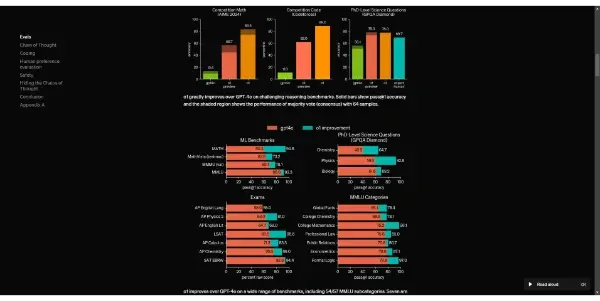OpenAI o1

This new AI model from OpenAI has been reinforcement-trained for complex reasoning. It can think internally before answering you. It outperforms humans in some difficult tests
OpenAI o1: A Powerful New LLM for Complex Reasoning
OpenAI's o1 represents a significant advancement in Large Language Model (LLM) technology. This reinforcement-trained model is designed for superior complex reasoning capabilities, setting it apart from its predecessors. Unlike many LLMs that generate responses directly, o1 incorporates a crucial internal reasoning step before formulating its output, leading to more accurate and nuanced answers, even surpassing human performance in specific challenging tasks.
What OpenAI o1 Does
OpenAI o1 is a powerful LLM designed to tackle complex reasoning problems. It excels in scenarios requiring multi-step thinking, logical deduction, and the integration of diverse information. The key innovation lies in its internal reasoning process: before generating a response, o1 internally deliberates and analyzes the problem, leading to significantly improved accuracy and reduced error rates compared to previous models. This internal processing allows it to handle ambiguity and uncertainty more effectively.
Main Features and Benefits
- Enhanced Reasoning Capabilities: o1's core strength lies in its ability to perform complex reasoning, outperforming humans in certain benchmark tests. This translates to more reliable and insightful answers, especially for intricate queries.
- Internal Reasoning Process: The model's unique internal deliberation phase ensures a more thoughtful and accurate response, reducing the likelihood of hallucinations or illogical conclusions.
- Improved Accuracy: The internal reasoning mechanism results in a demonstrably higher accuracy rate compared to other LLMs, particularly in tasks requiring analytical thinking.
- Handling Ambiguity: o1 is better equipped to manage ambiguous questions and situations, offering well-reasoned responses even when faced with incomplete or contradictory information.
Use Cases and Applications
The advanced reasoning capabilities of o1 open doors to numerous practical applications across various sectors:
- Scientific Research: Assisting researchers in analyzing complex datasets, formulating hypotheses, and identifying patterns.
- Financial Modeling: Building sophisticated financial models, predicting market trends, and assessing risk.
- Legal Analysis: Interpreting complex legal documents, identifying relevant precedents, and assisting in legal research.
- Software Engineering: Debugging complex code, identifying potential vulnerabilities, and assisting in software design.
- Medical Diagnosis Support: Analyzing patient data and assisting medical professionals in making more informed diagnoses (though human oversight remains crucial).
- Strategic Planning: Supporting strategic decision-making by analyzing complex scenarios and predicting potential outcomes.
Comparison to Similar Tools
While direct comparisons require access to o1's performance on specific benchmarks against competitors like GPT-4, PaLM 2, and Claude, OpenAI highlights o1's superior reasoning abilities. Existing LLMs often struggle with intricate problems requiring multiple steps of reasoning. o1's internal reasoning process distinguishes it, potentially making it a more reliable tool for complex tasks requiring high accuracy and logical consistency. More comparative studies and benchmark results are expected to emerge as o1 becomes more widely available.
Pricing Information
OpenAI o1 is a paid service. Specific pricing details, including per-token costs, API access fees, and usage tiers, are likely to be released by OpenAI separately upon official product launch and wider availability. The pricing structure will likely depend on factors such as usage volume and access level.
Conclusion
OpenAI o1 represents a significant leap forward in LLM technology. Its emphasis on internal reasoning and demonstrated superior performance in complex reasoning tasks make it a promising tool for a wide range of applications demanding high accuracy and logical consistency. While specific pricing details are pending, its enhanced capabilities suggest a valuable asset for organizations and individuals needing advanced analytical and reasoning capabilities. Further development and wider adoption will solidify its place among the leading LLMs in the market.